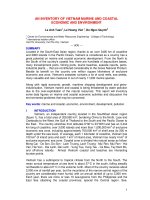Codes and Standards ppt
Bạn đang xem bản rút gọn của tài liệu. Xem và tải ngay bản đầy đủ của tài liệu tại đây (72.58 KB, 5 trang )
Codes and Standards
C Parker, International Lead Zinc Research Organization, Durham, NC, USA
& 2009 Elsevier B.V. All rights reserved.
Introduction
The terms codes and standards are almost synonymous;
they have essentially the same meaning. They are dif-
ferent in that codes are usually requirements imposed by
regulatory authorities, whereas standards are consensus
documents adopted voluntarily by organizations with a
common interest in a technology, product, or practice. A
standard issued by a professional organization as a con-
sensus document may subsequently be imposed on an
industry or product as a requirement and subsequently
referred to as a code. Regardless of the terminology,
codes and standards play an enormous, beneficial role in
the lives of ordinary citizens of every society. We pur-
chase appliances for our homes with little thought of
their power requirements; we are confiden t that our
homes’ electrical systems will provide a suitable voltage
and connecting plug for any appliance we choose. A
screw can be purchased in one country to fit a product
made in another, and the color s of traffic lights have the
same significance around the globe. Standards are cred-
ited with enhancing quality, reliability, safety, efficiency,
and utility of the products we use while concurrently
reducing their cost-to-value ratios. As electrochemical
power sources increase in numbers and applications, they
will increasingly be affected by codes and standards that
define their electrical attributes and the attributes of their
likely loads and applications.
A cursory search of the Web for ‘codes and standards’,
for ‘standards’, and for ‘standards-making organizations’
produced, in round numbers, millions of hits. The mag-
nitudes of thes e numbers are daunting and so large as to
be relatively useless; but they are suggestive of the impact
of standards on our societies. Adding descriptive ad-
jectives, of course, yields more manageable numbers. The
focus of this article is electrochemical power sources, for
example, batteries. The Institute of Electrical and Elec-
tronic Engineers (IEEE) is a standards development or-
ganization and a likely source for standards relevant to
batteries. A search of the IEEE website ( www.ieee.org)
for standards with titles that include the term batteries
yielded about 44 hits. Each entry included the title of the
standard and the year it was approved as a standard. The
44 titles provided additional information. Nineteen were
relevant to lead–acid batteries, 10 to nickel–cadmium
batteries, and 15 were generic, that is, they did not spe-
cify the type of battery. Some titles also referred to
specific applications. These application terms included,
for example, terms such as stationary, photovoltaics,
stand-alone photovoltaics, uninterruptible power sys-
tems, remote hybrid power systems, nuclear power
generation, emergency standby power, photovoltaic (PV)
hybrid power, and rail vehicles. The website suggested
that abstracts were provided for some standards, but none
appeared with these entries.
The electrical output of electrochemical power
sources is direct current (d.c.) electricity; however, many,
perhaps most, of the loads they support will require al-
ternating current (a.c.) electricity at a standard voltage
and frequency. A likely result is the evolution of a family
of d.c. to a.c. inverters with a.c. voltages that are com-
patible with current standards and, with continued
growth, additional standardization to define a family of
interface parameters for the power source–inverter
interface. These standards would reduce the number of
inverter parameters that affect designs to a more man-
ageable number, and they would enhance the likelihood
that component parts produced in multiple countries
would work well together.
International traveler s are routinely reminded of the
benefits of standardization by the necessity of acquiring
adapters for personal items such as hair dryers and
computers/chargers purchased in their native countries
to the electrical systems of some foreign countries. The
electrical systems among countries are not necessarily
standardized. Standard voltages and frequencies in North
America differ from their counterparts in Europe, for
example, because the attributes of these different systems
were established (and standardized locally) before
international standardization became the norm.
A brief historical perspective of standardization is of
interest. Relics from ancient civilizations suggest that
standards have been used for thousands of years; the
earliest standards were physical weights and measures
against which other weights and measures could be
compared. As trade and commerce developed, written
documents, that is, contracts, evolved, which recorded
mutual agreements between suppliers and consumers for
products and services. Industrialization in the nineteenth
century exposed an urgent need for standardization in
the interest of efficiency, economy, and safety. The
American Society of Mechanical Engineers, one of the
first voluntary standardizing organizations, was estab-
lished in 1880 when, according to their records, over
50 000 fatalities a year were being caused by explosions in
pressure systems. By the close of the nineteenth century,
539









